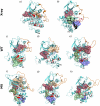Mutation D816V alters the internal structure and dynamics of c-KIT receptor cytoplasmic region: implications for dimerization and activation mechanisms
- PMID: 21698178
- PMCID: PMC3116893
- DOI: 10.1371/journal.pcbi.1002068
Mutation D816V alters the internal structure and dynamics of c-KIT receptor cytoplasmic region: implications for dimerization and activation mechanisms
Abstract
The type III receptor tyrosine kinase (RTK) KIT plays a crucial role in the transmission of cellular signals through phosphorylation events that are associated with a switching of the protein conformation between inactive and active states. D816V KIT mutation is associated with various pathologies including mastocytosis and cancers. D816V-mutated KIT is constitutively active, and resistant to treatment with the anti-cancer drug Imatinib. To elucidate the activating molecular mechanism of this mutation, we applied a multi-approach procedure combining molecular dynamics (MD) simulations, normal modes analysis (NMA) and binding site prediction. Multiple 50-ns MD simulations of wild-type KIT and its mutant D816V were recorded using the inactive auto-inhibited structure of the protein, characteristic of type III RTKs. Computed free energy differences enabled us to quantify the impact of D816V on protein stability in the inactive state. We evidenced a local structural alteration of the activation loop (A-loop) upon mutation, and a long-range structural re-organization of the juxta-membrane region (JMR) followed by a weakening of the interaction network with the kinase domain. A thorough normal mode analysis of several MD conformations led to a plausible molecular rationale to propose that JMR is able to depart its auto-inhibitory position more easily in the mutant than in wild-type KIT and is thus able to promote kinase mutant dimerization without the need for extra-cellular ligand binding. Pocket detection at the surface of NMA-displaced conformations finally revealed that detachment of JMR from the kinase domain in the mutant was sufficient to open an access to the catalytic and substrate binding sites.
Conflict of interest statement
The authors have declared that no competing interests exist.
Figures









References
-
- Olsen JV, Blagoev B, Gnad F, Macek B, Kumar C, et al. Global, in vivo, and site-specific phosphorylation dynamics in signaling networks. Cell. 2006;127:635–648. - PubMed
-
- Manning G, Whyte DB, Martinez R, Hunter T, Sudarsanam S. The protein kinase complement of the human genome. Science. 2002;298:1912–1934. - PubMed
-
- Manning G, Plowman GD, Hunter T, Sudarsanam S. Evolution of protein kinase signaling from yeast to man. Trends Biochem Sci. 2002;27:514–520. - PubMed
-
- Hunter T, Plowman GD. The protein kinases of budding yeast: six score and more. Trends Biochem Sci. 1997;22:18–22. - PubMed
-
- Hanks SK, Hunter T. Protein kinases 6. The eukaryotic protein kinase superfamily: kinase (catalytic) domain structure and classification. FASEB J. 1995;9:576–596. - PubMed
Publication types
MeSH terms
Substances
LinkOut - more resources
Full Text Sources
Miscellaneous

